|
| A low-flow channel included
so fish will be able to travel
regardless of water level |
Thank you to Joe McMullen for a wonderful tour of the Geddes Brook wetlands restoration project. You can see some of Randy Nonenmacher's photos of the event on Wikimedia showing many of the plants that grow there -- native and non-native. Thank yous, too, to Carol Biesemeyer for organizing this event and to Randy Nonenmacher for the Skaneateles field trips. See below for details about the next Show Me Help Me field trip to Skaneateles. One is open only to Wild Ones / HGCNY members, but it's not too late to join Wild Ones if you'd like to attend a members-only trip. (See sidebar for details on how to join Wild Ones.) We'll be hosting other Show Me Help Me tours during the summer. Native Plant Shopping Guide See details below to get your free Guide to help make it easier to find native plants in Central New York. We welcome feedback on your experiences with the vendors and the plants. Janet Allen, President
|
 |
Humans are disappearing ...
|
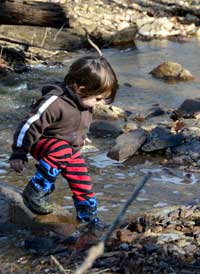 Okay, not really, but here's the complete quote: ~ Tim Gill, in the infographic The Big Disconnect.The introduction to the infographic:"For the first time in human history, more people live in cities than in rural environments. Instead of inhabiting wide open green spaces we live in crowded concrete jungles, spending over 90% of our time indoors and away from the natural environment.The urban migration has important physical, mental and cognitive implications. We urgently need to wake up to the link between human health and the natural environment and make a personal and collective commitment to reconnect with the great outdoors." To learn more about the issue of The Big Disconnect and for some interesting statistics, see the David Suzuki Foundation's infographic. (Just click on it to enlarge it.) Hometown National ParkDavid Suzuki has created a small "Homegrown National Park" in Toronto. He was Inspired by Richard Louv, who wrote Last Child in the Woods and The Nature Principle, and by Doug Tallamy's idea that the totality of our home landscapes could more than equal the amount of nature found in all our national parks. He has crowd-sourced a vibrant green corridor along the former path of Garrison Creek, in the City of Toronto's downtown west end. Read more about it on the David Suzuki Foundation website. (And by the way, if you have never heard his then-12-yr-old daughter's 7 minute speech before the UN at the Rio Summit 1992, it's worth watching.) More on the relationship of people and the environment in the People section of Our Habitat Garden.
|
 |
Garden Rant: Though gardeners seem to have been programmed to buy peat and are as loyal to the product as some car-buyers used to be about their beloved Pontiacs, there's simply no need to use it. Chopped leaves make a much better and more attractive mulch, and compost is superior as a soil amendment. ~ Ken Druse, author of The Natural Habitat Garden Read the whole Garden Rant on peat moss...Environmental costsAs Organic Gardening says: It forms over many millennia in bogs, marshes, and swamps-known as peatlands or peat bogs-often gaining less than a millimeter in depth every year.Besides releasing carbon, peat mining destroys the bog ecosystem. Although some brands claim to be harvested "sustainably," as Organic Gardening says: Can a resource that renews itself this slowly ever be considered sustainable? If we balk at cutting down 500-year-old trees in old-growth forests, should we accept the extraction of 3,000-year-old sphagnum moss from peat bogs?Read the whole article...
|
 |
 |
The Million Pollinator Garden Challenge is a campaign to register a million public and private gardens and landscapes to support pollinators.
From the website:
Pollinators are responsible for 1 out of 3 bites of food we take each day, and yet pollinators are at critical point in their own survival. Many reasons contribute to their recent decline. We know for certain, however, that more nectar and pollen sources provided by more flowering plants and trees will help improve their health and numbers. Increasing the number of pollinator-friendly gardens and landscapes will help revive the health of bees, butterflies, birds, bats and other pollinators across the country.A pollinator garden should:* use groupings of plants that provide both nectar and pollen (pollen is important for raising their young) * be in a sunny area with windbreaks * have plants in bloom throughout the season * provide nest areas in wood (snags, logs, and even bee houses) and ground (NOT covered in mulch or landscape cloth) * have a water source available * preferably eliminate pesticides (or at least minimize their impact by carefully following directions) For more info and links go to Our Habitat Garden's section on Bees. The National Pollinator Garden Network (NPGN) is an unprecedented collaboration of national, regional, and local gardening clubs. Wild Ones is one of the partners in this effort. Its founding private nonprofit and garden industry members were convened in Fall 2014, to propose efforts to help restore critical pollinator populations in support of the President's Executive Strategy to "Promote the Health of Honey Bees and Other Pollinators." To register your pollinator garden, go to S.H.A.R.E. (Simply Have Areas Reserved for the Environment).
|
 |
Skaneateles Conservation Area
Show Me Help Me Field Trip
Sat. June 13 and Sat. June 20 This area is an abandoned USDA Soil Research Station (and briefly an Army helicopter training site). Much of it now consists of highly-degraded fields of buckthorn, honeysuckle, privet, and multiflora rose. Volunteers have been removing some of the invasives within the last few years, but they could use some ideas about good replacements. See http://skaak.org/the-areas/federal-farm/ for historic aerial images of the site, and
http://skaak.org/the-areas/federal-farm/federal-farm-clippings/ for some history. Randy will "SHOW" us what they've been doing to remove the invasives and what the result has been over the last few years, and he's interested in our "HELP" as part of this Show Me Help Me Field Trip. Because this is public land, only licensed applicators are allowed to apply herbicides, so many of the invasives re-sprout and need to be recut over and over. It has made room for some natives to pop up on their own, but those need to be protected from herbivores, and it's only a limited number of species. Dr. McGee (at June 13 trip only) will help answer the more difficult questions and provide suggestions of his own. His Wildflower Restoration project is being done on a site (the Guppy Farm, on the other side of Gully Road) that was reforested earlier and has less of an invasive species problem, but native woodland wildflowers are absent. See more about that project at http://skaak.org/flora-2/wildflower-restoration/. In addition to Dr. McGee, Geoff Griffiths, a Ph.D. Ecology student at SUNY-ESF, will also be our guide at both the June 13 and the June 20 programs. RSVPs
Sat. June 13 at 10 am. Open to Wild Ones members. RSVP to Carol at cbieseme@twcny.rr.com. Sat. June 20 at 10 am. Open to all. RSVP to Randy Nonenmacher at ranonenmacher@twcny.rr.com. Details will be sent to registrants. |
 |
 |
|
2015 Native Plant Shopping Guide
|
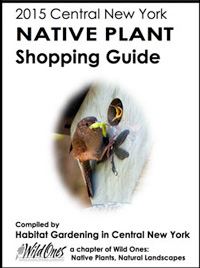 The most common question people have asked over the years is "Where can we get native plants?" Central New York does seem to be behind other areas of the country in making native plants available, but each year there are more plants available, and our Native Plant Shopping Guide will tell you where to find them. Download it for free on our websiteThe Guide is in three parts:
Or you can download the complete Guide (Introduction, List by scientific name, and List by common name).
Please read the introduction! In addition to information about the vendors, it suggests guidelines for choosing plants. For example, it's beneficial to choose species rather than cultivars. The Introduction provides additional information. New this year is a link (the asterisk in the left hand column) to a map of each plant's distribution county by county as part of the Biota of North America Program at http://bonap.net/NAPA/Genus/Traditional/County. If you're looking for a particular plant, be sure to call ahead to be sure the vendor has them in stock on any particular day. Thank you to our vendors for taking the time and effort to provide a list of their native plant offerings. Special thanks to Randy Nonenmacher, Carol Biesemeyer, and Randi Starmer for their assistance. And THANKS to all of you who choose native plants! |
 |
|
|
|
Thorndon Park Garden Tour THIS SUNDAY June 14, 1 pm - 4 pm
|
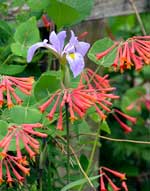 The 17th Annual Thornden Park Garden Tour will feature the gardens of faculty and alumni of SUNY-ESF. HGCNY-ers will be especially interested to know that one of the featured gardens is that of Don Leopold, author of Native Plants of the Northeast and popular HGCNY speaker. For more info, visit the Thornden Park Association website. $10/person.
|
Onondaga Audubon: Geese of Central NY
WED. JUNE 10
|
To learn about geese, Jeff Benjamin is conducting a remote camera study at Junius Ponds Unique Area in Seneca County. He will explain how flock composition and weather conditions both affect migration timing and influence daily movements of Canada geese. Jeff will also describe the broader ecology of both Canada and Snow Geese in Central New York. WHEN: Wed. June 10 6 pm bird viewing 7 pm program WHERE: Onondaga Lake Visitors Center FREE!
For more information and directions
|
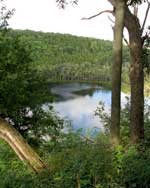 This tradition has been a highlight at Clark Reservation for years! Join Dr. Leopold as he introduces us to the many trees and plants found here at Clark Reservation. You may even spot a rare plant or two along the way. After the hike, join the Council of Park Friends for refreshments. WHEN: Sun. June 21 at 2 pm WHERE: Clark Reservation State Park FREE with admission to the park ($4/car). For more info...
|
|
MOST Exhibit:
Losing a Legacy
|
|
| |
Climbing a glacier in Glacier Nat'l Park in 1977 - disappearing in my lifetime
|
The Museum of Science & Technology (MOST) has a photography exhibit, "Losing a Legacy: A Photographic Story of Disappearing Glaciers," chronicling the disappearance of glaciers from Glacier National Park in Montana due to climate change. WHEN: Ends June 30 WHERE: MOST, 500 South Franklin St. Syracuse (315) 425-9068 Directions and parkingFor more info about the exhibit...
|
Since HGCNY is a chapter of the national organization Wild Ones, when you become a member of Wild Ones, you're automatically a member of HGCNY, too. And since Wild Ones is an official not-for-profit, your membership is tax-deductible.
It's easy to become a member, receive the bimonthly Wild Ones Journal, and support our mission.
|
As more of us participate on our Facebook page at www.facebook.com/hgcny, this will become a useful resource for asking (and answering!) local HGCNYers' questions about habitat gardening.
|
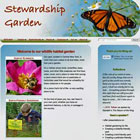 Visit Our Habitat Garden website for information on providing habitat, earth-friendly gardening practices, plants, and various creatures here in Central New York. |
Visit Our Edible Garden website to see an example of a local vegetable and fruit garden. An edible garden is a perfect complement to your habitat garden. Email me if you want to receive a vegetable gardening e-newsletter.
|
|
 |
|